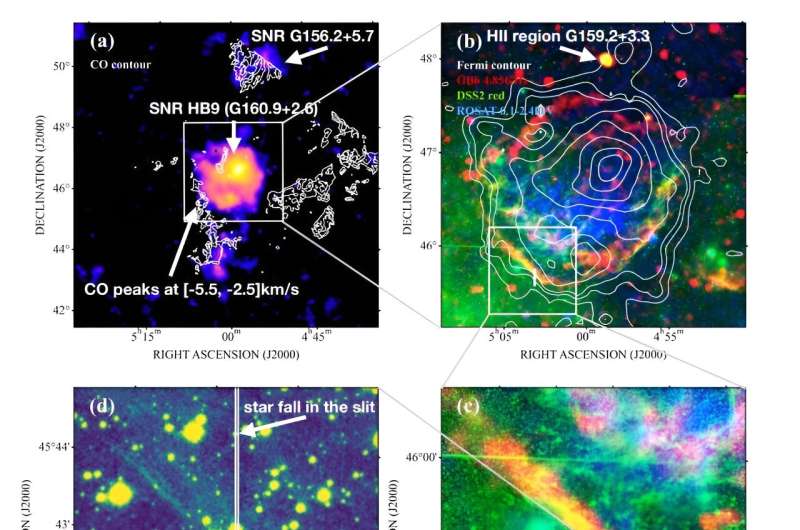August 19, 2024 report
This article has been reviewed according to Science X's editorial process and policies. Editors have highlighted the following attributes while ensuring the content's credibility:
fact-checked
preprint
trusted source
proofread
Observations investigate the connection of a supernova remnant with a nearby H II region

Chinese astronomers have performed multi-wavelength observations of a galactic supernova remnant known as HB9. Results of the observational campaign, published August 9 on the preprint server arXiv, shed more light on the remnant's properties and its possible physical connection with a nearby region of ionized atomic hydrogen (H II region).
Supernova remnants (SNRs) are diffuse, expanding structures resulting from a supernova explosion. They contain ejected material expanding from the explosion and other interstellar material that has been swept up by the passage of the shockwave from the exploded star.
Studies of supernova remnants are important for astronomers, as they play a key role in the evolution of galaxies, dispersing the heavy elements made in the supernova explosion and providing the energy needed for heating up the interstellar medium. SNRs are also believed to be responsible for the acceleration of galactic cosmic rays.
Observations show that young stars form in giant molecular clouds, ionizing the surrounding gas and form H II regions. Afterward, when the stars explode, they leave SNRs in these regions. However, the physical connection between SNRs and surrounding H II regions has not been comprehensively studied yet.
HB9 is a relatively young (about 6,600 years old), large galactic SNR located some 2,000 light years away, with a small H II region G159.2+3.3 apparently projected nearby. HB9 showcases a shell-type radio morphology and its angular size is estimated to be approximately 2 degrees in diameter. When it comes to G159.2+3.3, it appears brighter, more compact than HB9 and is located about 2 degrees north from the southern edge of the SNR's shell.
Now, a team of astronomers led by Jiang-Tao Li of the Purple Mountain Observatory in Nanjing, China, has employed the McGraw-Hill 1.3m telescope at the Michigan-Dartmouth-MIT (MDM) observatory, to inspect the possible physical connection between HB9 and G159.2+3.3.
The observations found that HB9 is bright in gamma-rays but its morphology is not clearly associated with the surrounding molecular clouds. However, a weak apparent connection of this remnant to the infrared bright enclosing shell of G159.2+3.3 has been identified in gamma-rays.
The obtained data show that the multi-wavelength morphology of G159.2+3.3 is typical for galactic H II regions. This suggests that the Balmer line and radio emissions in the interior are thermal in origin, while the infrared bright shell consists of dust heated by the ultraviolet photons from young stars.
The study found that the radial velocity of the southeast shell of HB9 is within the range of -30 and +50 km/s. This, according to the astronomers, indicates possible SNR shock heating of the gas.
Furthermore, the researchers calculated a median electron density for the southeast shell of HB9, which turned out to be at a level of 100 cm-3. What is noteworthy, a smaller median value, of about 50 cm-3, was obtained for the brighter G159.2+3.3. This, according to the authors of the paper, could mean that the distance of G159.2+3.3 is indeed larger than that of HB9, so the two objects are not physically connected to each other.
"Our density estimate suggests that G159.2+3.3, although appearing brighter and more compact, is likely located at a much larger distance than HB9, so the two objects have no physical connections, unless the shock compressed gas in HB9 has a significantly lower filling factor," the scientists concluded.
More information: Jiang-Tao Li et al, Optical observations of the Galactic SNR HB9 and H II region G159.2+3.3, arXiv (2024). DOI: 10.48550/arxiv.2408.05016
Journal information: arXiv
© 2024 Science X Network





















